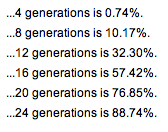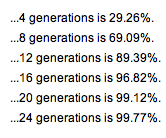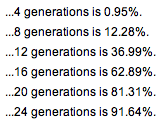We now have three data points. One Unkefer descendant, one Uncapher descendant, and one with the original Ungefehr surname whose family never left Germany.
We have a paper trail for the connection in the United States between the Unkefer and Uncapher families. The most recent common ancestor (MRCA) should be Johann Martin Ungefehr, who emigrated from Lambsheim, Germany to York County, Pennsylvania in 1723. According to the family tree, this should be about 8 generations.
Based on the specific mutations that the Unkefer and Uncapher descendants show, FTDNA (the company that does the DNA tests) calculates the probabilities of the TMRCA (time to most recent common ancestor) like this:
Remember, these are probabilities. We know that the MRCA is around 8 generations, so the probabilities appear to be understated. But mutations are random, so it’s possible these two individuals have some mutations that happened in the last generation or two. Even a father and son might not match 100%.
As expected, the MRCA for the American branches of the family and the family still in Germany is farther back. We haven’t yet established a paper trail connecting the German descendant’s ancestor with Johann Martin Ungefehr’s ancestors, but we are fairly certain it is at minimum 2 generations earlier and more likely 4 generations earlier, or sometime in the mid-sixteenth century. That is, our estimate for the TMRCA for the American and German branches is 12-15 generations. The FTDNA probabilities look like this:
Comparing Uncapher to Ungefehr: ComparingUnkefer to Ungefehr:
 Since we know both Uncapher and Unkefer are descended from the same immigrant ancestor, they should have the same TMRCA when comparing to the the Ungefehr whose family stayed in Germany, but the probabilities are slightly different. This has to do with the mutation rates of the specific markers where the mutations occur. The individuals tested might also be different generations from each other.
Since we know both Uncapher and Unkefer are descended from the same immigrant ancestor, they should have the same TMRCA when comparing to the the Ungefehr whose family stayed in Germany, but the probabilities are slightly different. This has to do with the mutation rates of the specific markers where the mutations occur. The individuals tested might also be different generations from each other.
Testing more markers on Uncapher and Ungefehr would further refine the data and possibly close the gap between the paper trail and the probabilities. Testing more descendants would also help, as probabilities are more accurate with more data. We might be able to discern when some of the mutations occurred (after the geographic separation vs. before).
If you are a male Ungefehr descendant, regardless of the spelling of your name (but your father’s father’s father’s father etc. must be descended from an Ungefehr), and you would like to participate, order a test kit through FTDNA and join the project. Please order a Y-37, Y-67 or Y-111 test. The number refers to the number of markers–the more markers, the better the project’s data will be. The project administrators do not benefit financially–this project is fueled by interest in genealogy and genetics and history.
To see the marker comparisons, click on the link below.


